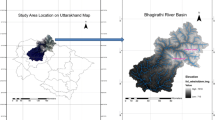Abstract
The development of temperature forecasting models for the state of Kerala using Seasonal Autoregressive Integrated Moving Average (SARIMA) method is presented in this article. Mean maximum and mean minimum monthly temperature data, for a period of 47 years, from seven stations, are studied and applied to develop the model. It is expected that the time-series datasets of temperature to display seasonality (and hence non-stationary), and a possible trend (due to the fact that the data spans 5 decades). Hence, the key step in the development of the models is the determination of the non-stationarity of the temperature time-series, and the transformation of the non-stationary time-series into a stationary time-series. This is carried out using the Seasonal and Trend decomposition using Loess technique and Kwiatkowski–Phillips–Schmidt–Shin test. Before carrying out this process, several preliminary tests are conducted for (1) finding and filling the missing values, (2) studying the characteristics of the data, and (3) investigating the presence of the trend and seasonality. The non-stationary temperature time-series are transformed to stationary temperature time-series, by one seasonal differencing and one first-order differencing. This information, along with the original time-series, is further utilized to develop the models using the SARIMA method. The parsimonious and best-fit SARIMA models are developed for each of the fourteen variables. The study revealed that \(\text{SARIMA}(2,1,1)(1,1,1)_{12}\) as the ideal forecasting model for eight out of the fourteen time-series datasets.





Similar content being viewed by others
References
Aguado-Rodríguez GJ, Quevedo-Nolasco A, Castro-Popoca M, Arteaga-Ramírez R, Vázquez-Peña MA, Zamora-Morales BP (2016) Predicción de variables meteorológicas por medio de modelos arima. Agrociencia 50(1):1–13
Allen MR, Ingram WJ (2002) Constraints on future changes in climate and the hydrologic cycle. Nature 419(6903):228–232
Andronova NG, Schlesinger ME (2000) Causes of global temperature changes during the 19th and 20th centuries. Geophys Res Lett 27(14):2137–2140
Arjun KM (2013) Indian agriculture-status, importance and role in Indian economy. Int J Agric Food Sci Technol 4(4):343–346
Cleveland RB et al (1990) Stl: a seasonal-trend decomposition procedure based on loess. citeulike-article-id:1435502
Gilbert RO (1987) Statistical methods for environmental pollution monitoring. Wiley, New York
Gocic M, Trajkovic S (2013) Analysis of changes in meteorological variables using Mann–Kendall and Sen’s slope estimator statistical tests in Serbia. Glob Planet Change 100:172–182
Hänsel S, Medeiros DM, Matschullat J, Petta RA, de Mendonça Silva I (2016) Assessing homogeneity and climate variability of temperature and precipitation series in the capitals of North-Eastern Brazil. Front Earth Sci 4:29
Hyndman RJ, Athanasopoulos G (2018) Forecasting: principles and practice. OTexts, Melbourne
Indian Network for Climate Change Assessment and India Ministry of Environment (2010) Climate Change and India: a 4 × 4 assessment, a sectoral and regional analysis for 2030s, vol 2. Ministry of Environment & Forests, Government of India, New Delhi
Jain SK, Kumar V (2012) Trend analysis of rainfall and temperature data for India. Curr Sci 102:37–49
Kang H (2013) The prevention and handling of the missing data. Korean J Anesthesiol 64(5):402
Kendall M (1975) Rank correlation methods. Charles Griffin, London (There is no corresponding record for this reference)
Kocsis T, Kovács-Székely I, Anda A (2017) Comparison of parametric and non-parametric time-series analysis methods on a long-term meteorological data set. Cent Eur Geol 60(3):316–332
Kocsis T, Kovács-Székely I, Anda A (2020) Homogeneity tests and non-parametric analyses of tendencies in precipitation time series in Keszthely, Western Hungary. Theor Appl Climatol 139(3–4):849–859
Kwiatkowski D, Phillips PC, Schmidt P, Shin Y et al (1992) Testing the null hypothesis of stationarity against the alternative of a unit root. J Econom 54(1–3):159–178
Lai Y, Dzombak DA (2020) Use of the autoregressive integrated moving average (ARIMA) model to forecast near-term regional temperature and precipitation. Weather Forecast 35:959–976
Mann HB (1945) Nonparametric tests against trend. Econom J Econom Soc 13:245–259
Mills TC (2014) Time series modelling of temperatures: an example from k efalonia. Meteorol Appl 21(3):578–584
Radziejewski M, Kundzewicz ZW (2004) Detectability of changes in hydrological records/possibilité de détecter les changements dans les chroniques hydrologiques. Hydrol Sci J 49(1):39–51
Sen PK (1968) Estimates of the regression coefficient based on Kendall’s tau. J Am Stat Assoc 63(324):1379–1389
Tiwari P, Kar S, Mohanty U, Dey S, Kumari S, Sinha P (2016) Seasonal prediction skill of winter temperature over North India. Theor Appl Climatol 124(1–2):15–29
Trenberth KE (1999) Conceptual framework for changes of extremes of the hydrological cycle with climate change. In: Weather and climate extremes. Springer, Dordrecht, pp 327–339
Wang H, Huang J, Zhou H, Zhao L, Yuan Y (2019) An integrated variational mode decomposition and arima model to forecast air temperature. Sustainability 11(15):4018
Wanishsakpong W, Owusu BE (2020) Optimal time series model for forecasting monthly temperature in the southwestern region of Thailand. Model Earth Syst Environ 6(1):525–532
Acknowledgements
The first author would like to thank the Ministry of Human Resource Development (MHRD) for the financial support, which was provided in the form of research stipend. The authors also acknowledge the Indian Meteorological Department (IMD) for the temperature datasets.
Author information
Authors and Affiliations
Corresponding author
Ethics declarations
Conflict of interest
The authors declare that they have no conflict of interest.
Rights and permissions
About this article
Cite this article
Kabbilawsh, P., Sathish Kumar, D. & Chithra, N.R. Trend analysis and SARIMA forecasting of mean maximum and mean minimum monthly temperature for the state of Kerala, India. Acta Geophys. 68, 1161–1174 (2020). https://doi.org/10.1007/s11600-020-00462-9
Received:
Accepted:
Published:
Issue Date:
DOI: https://doi.org/10.1007/s11600-020-00462-9




